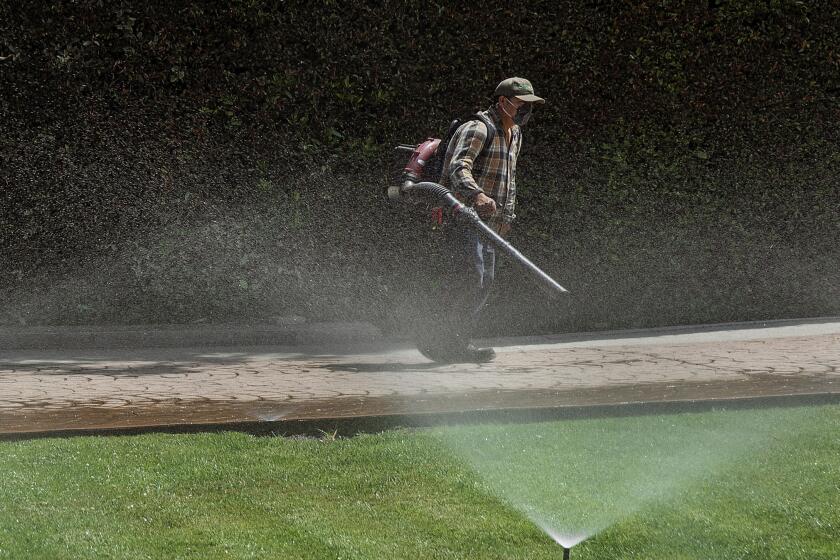From Site of Ancient Tribal Tree, the City of Angels Grew
- Share via
It was already ancient when it was chopped down more than a century ago, the sycamore tree that forever fixes in time and place the village that existed for three millenniums--the earliest site of what became Los Angeles.
While Christopher Columbus was setting foot on the shores of the West Indies in the fall of 1492, a seedling began to grow near the Pacific shores that Juan Rodriguez Cabrillo would discover half a century later.
In its 400 years, the tree would provide shelter for the highest councils of an Indian nation, serve as a landmark to the Spanish soldiers and become ground zero for the city of Los Angeles.
And now a historian has used the tree to settle a century-old debate over the exact site of Yangna, the central village of the Gabrielino Indians, and the seed of the settlement that became Los Angeles.
*
Centuries before the Mexicans arrived and christened the huge sycamore tree “El Aliso,” more than 200 Gabrielinos lived in Yangna, the largest of the 100 or so villages that 5,000 Gabrielinos called home. Chiefs from these lesser villages would travel to meet under the spreading branches of the “council tree.”
The precise location of Yangna has always been a mystery, one that local historians and anthropologists have sought to solve. Some placed it variously at City Hall, Union Station, Pershing Square and the Los Angeles Children’s Museum.
But now, John Crandell, a Sunland landscape architect/urban designer and vice president of the L.A. Millennium Project, has discovered what he believes to be the exact location of the village--along what is now a center divider on the 101 just south of the Metropolitan Transportation Authority headquarters.
His judgment may have been confirmed two years ago when excavations for elevator shafts for handicapped access near Olvera Street unearthed hundreds of artifacts, the oldest from a 3,000-year-old Gabrielino settlement at the edge of current-day downtown, then “a vast matrix of alders, cottons, sycamores and ash interspersed with tules or wetlands,” as Crandell described it.
In searching for Yangna, Crandell believes he may have solved another historical dilemma: fixing the site of the second Spanish settlement that became Los Angeles. (The first is still a mystery.) It was next to Yangna, he said, and existed for about 10 years.
The second settlement “was wiped out in the Great Flood of 1815, a flood that the tree survived and which then forced the pueblo dwellers to seek higher ground, where the central [historic] plaza is located today,” Crandell said. (The Gabrielinos, accustomed to living with flood cycles, routinely burned their wickiups and moved a few yards away.)
Historian Doyce Nunis Jr. speculates that the first Spanish settlement may have been built about half a mile from the site of the tree, and high up--on a 50-foot bluff on North Broadway, where St. Peter’s Italian Catholic Church sits today.
Nunis, editor of the journal of the Historical Society of Southern California, said an 1847 drawing by pioneer William Rich Hutton shows abandoned ruins on a very high bluff. “My suspicion is that the original pueblo site was north of the Yangna village. This drawing is probably the best clue we’ve ever had,” Nunis said.
Crandell agrees and points out the sycamore tree in the distance in the drawing. “Maybe the city’s first settlers got tired of carrying everything up the bluff and decided it would be easier to live on the flatlands.”
*
There is nothing left of Yangna, which Gaspar de Portola and his jolly friars, Juan Crespi and Francisco Gomez, chanced upon on their way to close escrow on Alta California for the king of Spain in 1769.
The Mexican city rulers who followed the Spaniards did to the Gabrielinos much of what the U.S. government would do to other tribes--took over their land and left them with smaller and smaller parcels.
Over the years, locals chipped away at Indian property. In June 1835, French immigrant and vineyard owner Jean-Louis Vignes took over the land on which the six-story-tall sycamore stood; he valued the tree at $20.
In the mid-1830s, the city council, or ayuntamiento, shrunk Yangna to a 100-vara-long triangle (one vara equals about 2 feet 9 inches). But even that only lasted little more than a decade. In 1846, the city rescinded that altogether, moving the tribe to the far side of the river.
Two years later, after 26 residents complained of noise generated by “disorderly gatherings” when American soldiers visited the village for unauthorized R & R, the military commander ordered the city to eliminate the village, “or else.”
Townsfolk contributed all of $24 to assist the remaining Gabrielinos--their numbers ravaged by decades of opium, liquor, disease and violence--to move their belongings to wherever they could find refuge.
But the tree remained. By the 1870s, the Philadelphia Brewery surrounded “El Aliso.” New brewery buildings encroached upon the sycamore, with its branches spreading 200 feet in diameter. By 1892, the Yangna council tree was dead.
Little Charles Gibbs Adams, who would become one of Los Angeles’ first landscape architects, watched as the tree was cut down. He counted its annual rings of growth and recorded its life span--400 years.
Crandell, who is working on a book called “Porciuncula” (Los Angeles River) has written to Mayor Richard Riordan and the owner of the land where the “council tree” once grew, suggesting that another sycamore be planted there to commemorate what once was, as well as the arrival of a new millennium here in Los Angeles.
More to Read
Sign up for Essential California
The most important California stories and recommendations in your inbox every morning.
You may occasionally receive promotional content from the Los Angeles Times.













